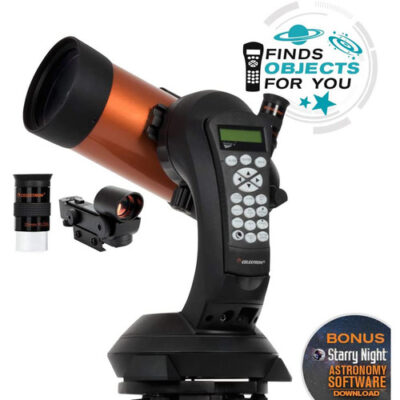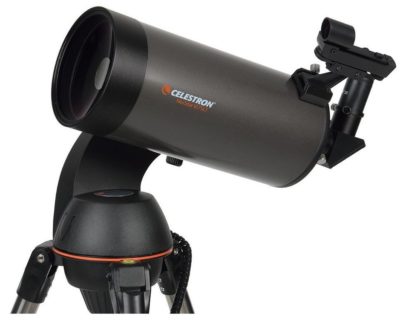

Though it’s not a pure Celestron travel scope, it’s a great choice if you’re getting started with basic astrophotography and need a little more quality for planetary viewing. Since the mount requires eight AA batteries, you will need to have confidence that they have enough juice. The small buttons of the hand controller can be a little fiddly, and you will need to set the time and date each time you use the scope, and you will need to put fresh batteries in to prevent it from cutting out and needing to be reset. The 4SE has a fairly steady mount, and the scope does have a Vixen dovetail creating the flexibility to use other mounts. This is typical of a Maksutov Cassegrain telescope, as they’re pretty expensive – you can look at the 5, 6 or even 8SE if you have a little more cash to spend. However, with the small aperture of the 4SE, you’re not likely to explore all of these objects, but it will help you to become more familiar with the night sky and develop your interest in the hobby. You will also get access to the NexStar catalog, which contains 40,000 objects. The NexStar 4SE is a little small, and with its 102 mm focal length, it is better suited to planetary astronomy, so you will be limited to looking at the brightest deep sky objects. Further high power or medium power eyepieces will allow you to get the most from your 4SE. This is great for low power, but you may want to add a 32 mm Plossi for a wide field of view. The NexStar 4SE has a single 1.25 inch or 25 mm single Plossi eyepiece. This scope has an auto orientation feature that allows you to view the image right side up rather than an inverted view on typical Cassegrains. This scope has a fast spherical primary mirror with an aluminized “spot” that serves as a secondary mirror on the corrector.ĭespite this small secondary mirror, this scope does offer great optics and a long focal length, so it is well suited for planetary, lunar, or double star gazing. The NexStar 4SE shares the heritage of its sibling, the C90, which is basically a scaled up version. Celestron NexStar 4SEĪperture: 102mm | Focal Length: 1325mm | Focal Ratio: f/13 This is the best Celestron Travel telescope when it comes to packing light but still having enough power for viewing objects. Need an extra Barlow: You may need additional accessories, as it comes with two eyepieces but combining these with an extra Barlow lens would be better for bright views with more detail.Battery powered : The telescope uses 8 AA batteries, so you’ll need plenty of batteries or a battery pack for long late nights.Great price: You can get this telescope for a reasonable price, which offers excellent value for money.Computerized system: This makes it extremely easy to find the Orion Nebula and other celestial objects in the night skies.Overall, it’s a great travel telescope that’s extremely easy to pack up and take away with you on a camping trip or journey outside of the City.

This is easier in heavier models of telescope, but with light telescopes a sturdy base is important. The mount has a built in bubble level, which is necessary to maintain balance. It’s a great telescope for any amateur astronomer. This is a Maksutov Cassegrain telescope that has a solid enough aperture and a long focal ratio, which means that it is designed for getting a wide view of the night sky. You can use the wireless remote included to locate different stars, moons and planets – you can just enter certain objects (like the Milky Way) and the computerized system will find them.
BEST TELESCOPE FOR VIEWING PLANETS AND GALAXIES PORTABLE
When it comes to portable telescopes, the Celestron NexStar 90SLT is really hard to beat. Aperture: 90mm | Focal Length: 1250mm | Focal Ratio: f/14


 0 kommentar(er)
0 kommentar(er)
